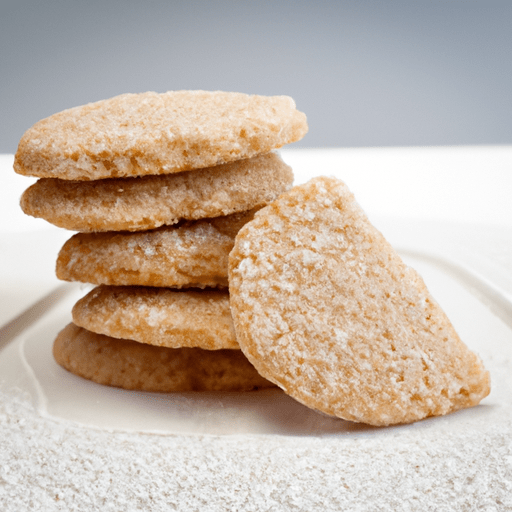Delicious and Gluten-Free: The Perfect Shortbread Cookie
Shortbread cookies are a beloved treat that have been enjoyed for centuries. But what if you follow a gluten-free diet? Does that mean you have to miss out on the buttery, crumbly goodness? Absolutely not! In this blog post, we will explore the world of gluten-free shortbread cookies and discover just how delicious and versatile they can be.
The Quintessential Taste of Shortbread
Shortbread cookies are renowned for their simplicity and rich flavor. The traditional shortbread taste is buttery, crisp, and slightly sweet. With a delicate balance of ingredients, these cookies have a unique melt-in-your-mouth texture that is distinctively their own. The gluten-free versions beautifully capture this essence, allowing everyone to savor the classic shortbread experience.
A Versatile Ingredient for Creative Cooking
Once you have a batch of gluten-free shortbread cookies on hand, a world of culinary possibilities opens up. You can enjoy the cookies as they are, with a cup of tea or coffee, or incorporate them into various recipes. Crumbled or crushed, they make a fantastic base for cheesecake crusts, pie crusts, or even as a topping for fruit crumbles. The possibilities are endless with these flavorful gluten-free gems.
Nutritional Benefits of Gluten-Free Shortbread
While shortbread cookies are undeniably indulgent, their ingredients boast some surprising nutritional benefits. Almond flour, often used as a gluten-free alternative, is rich in protein, healthy fats, and vitamin E. This flour imparts a subtly nutty flavor to the cookies, adding to the overall experience. Additionally, using natural sweeteners like honey or maple syrup instead of refined sugar can provide a more wholesome option for those conscious of their sugar intake.
A Trip Down History Lane
The origins of shortbread cookies date back to medieval Scotland. Originally referred to as “biskit bread,” shortbread was a luxury enjoyed by the wealthy. The recipe evolved over time, with butter becoming the prominent ingredient. In fact, Mary, Queen of Scots, was so enamored with shortbread that she popularized its “petticoat tails” shape. As time progressed, so did the variations of shortbread, leading us to the gluten-free adaptations we have today.
Interesting Facts About Shortbread Cookies
- Did you know that shortbread was traditionally given as a gift during the festive season in Scotland? It was a symbol of hospitality and good luck.
- The classic prickly pattern on the surface of shortbread cookies, created by piercing the dough with a fork, not only adds an elegant touch but also helps the cookies cook more evenly.
- In Scotland, January 6th is celebrated as “National Shortbread Day,” honoring this beloved treat with various events and festivities.
Conclusion
Gluten-free shortbread cookies are a testament to the fact that dietary restrictions don’t have to mean sacrificing flavor and enjoyment. With their delightful taste, versatility in cooking, and surprising nutritional benefits, these cookies are a delightful addition to any gluten-free kitchen. Whether you’re gluten-intolerant or simply want to explore new sweet treats, try making a batch of gluten-free shortbread cookies and savor the magic of this timeless classic.
Gluten-Free Shortbread Cookie
Origin: Shortbread originated in Scotland in the 12th century. It was originally made with just oatmeal, fat, and some sugar. Over time, variations were developed, including traditional shortbread made with wheat flour, and gluten-free shortbread for those with gluten sensitivity or celiac disease.
Common Uses: Gluten-free shortbread cookies are enjoyed as a tasty treat on their own or used as a base for desserts like crusts for pies or cheesecakes. They can also be crumbled or crushed to make flavorful toppings for ice cream or yogurt.
Nutritional Benefits: Gluten-free shortbread cookies made with alternative flours, such as rice flour or almond flour, can offer some nutritional benefits. For instance, almond flour is a good source of protein, healthy fats, vitamin E, and magnesium. It is also lower in carbohydrates compared to wheat flour.
Unique Properties: Gluten-free shortbread can have a slightly different texture compared to traditional shortbread due to the absence of gluten. It may be slightly crumbly but still retain a rich, buttery taste. Efforts are often made to replicate the melt-in-your-mouth texture that is characteristic of classic shortbread.
Historical Significance: While the origins of shortbread can be traced back to Scotland, gluten-free shortbread is a more recent development due to increased awareness and diagnosis of gluten sensitivity and celiac disease. It provides an option for those who need to avoid gluten but still want to enjoy the classic taste and experience of shortbread cookies.




Use the share button below if you liked it.
It makes me smile, when I see it.